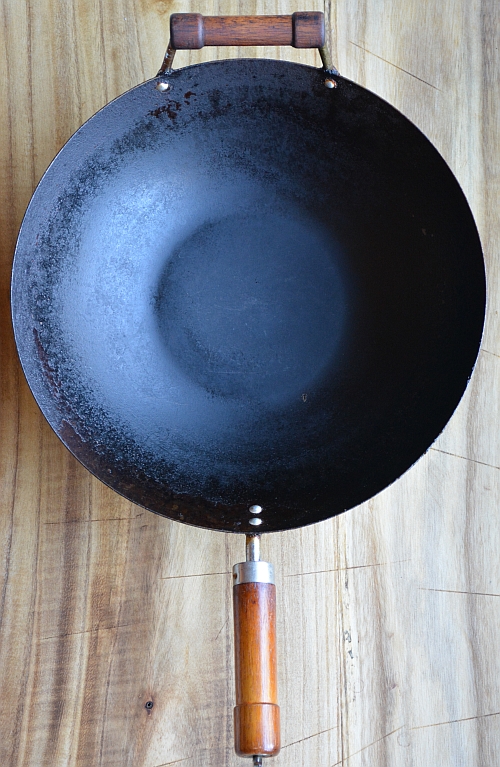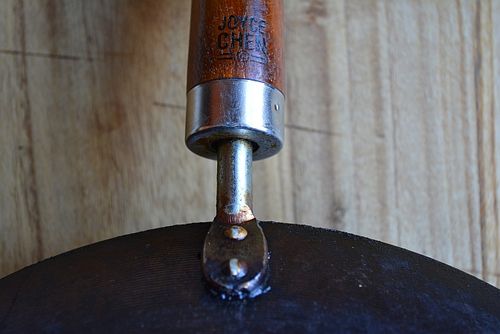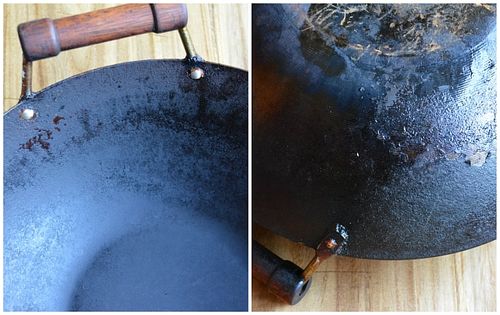
I often take pictures of my food cooking in a wok so it was no surprise when a couple of people asked about wok selection and care. Last week, Man Nghi wrote this: “I have the heavy Chinese cast-iron wok at home but often it is very useful to have a non-stick one too.” She’d seen one for about $59.99 and thought it pricey, which led to this question, “Is that the normal price for a good non-stick wok? I would ask my mother however she does not own one.”
Her comments hit on a lot of points for me, mainly that for decades, my mom didn’t have a wok at home. She stir-fried in a well-worn deep cast iron skillet. Viet cooks tend to not be big on woks. Chinese-Vietnamese people, like my friends Eric and Sophie Banh in Seattle, are more inclined to use them for cooking Viet fare. I can totally understand why Man Nghi’s mom isn’t a Viet wok user.
When I started out cooking for myself and tinkering with Chinese food, I initially tried a regular carbon-steel wok. My food kept sticking and I switched to using a large
nonstick skillet. In the late 1990s, I wanted to try the wok again but was gun shy. I bought a nonstick wok for about $20.
Non-stick coated wok pros and cons
The nonstick wok instantly made me feel like a Chinese food pro. Slices of marinated meat slid around the pan with ease. I turned out fabulous dishes as if I’d been using one for years. The trouble hit when the bits of nonstick coating came off into the food I was cooking.
I didn’t realize that you couldn’t heat the darn thing up at high temperatures without consequences. Stir-frying is about high heat, fast cooking. The flecks of black came off during a dinner party, as I was finishing up dishes to bring to the table. I picked out most of the bits and hoped for the best. The next day, I threw the wok away.
DIY nonstick wok
I didn’t cook with a wok until years later, after I’d been inspired by reading Grace Young’s Wisdom of the Chinese Kitchen. Grace was on a wok mission, arguing that
traditional woks worked best. Poking around a Ross Dress-for-Less one day, I
found the flat-bottomed wok you see here. As Tane Chan, owner of the Wok Shop in San Francisco says, a good wok doesn’t have to cost much. My $20 wok came in a box as a Joyce Chen kit and the unusual discovery of it at Ross of all places was akin to Asian cooking kismet (a cheap deal!). After assembling it, I threw away the other accoutrements as I can’t figure out how to comfortably wield those long chopsticks.

I followed Grace’s instructions to wash then season the wok with a bunch of Chinese chives (the same stuff used in classic Chinese dumplings!). Then I started cooking, blasting it with heat without fear of nonstick coating fleck coming off.
Food stuck time and time again. Watching me repeated scrape bits from the wok wall, my husband suggested that I buy a new wok. “Because the sticking is suppose to go away,” I’d responded in frustration.
Then I decided to deep-fry in the wok. Perhaps the oil would penetrate the metal to hasten the formation of a nonstick surface? Plus, less oil was required for wok frying and it heated up in a jiffy. About 2 years into using the wok once or twice a week, there was a beautiful black coating in the lower third. Food still stuck less, though stir-frying noodles or making fried rice could sometimes be challenging if the noodles or rice wasn’t dryish.
I rarely washed the outside of the wok, which is why it looks slightly crusty versus the smooth interior. A fast scrub after each use with hot water and maybe a drop of soap was all it took to clean up the wok. Then I dried it over a low flame while we ate dinner.

As the wok developed its patina, I found myself using it more often, even keeping it out on the stove for days on end. I didn't just like it. I loved it. The wok naturally became nonstick. I was even frying eggs in it, something I’d rarely do in my All Clad stainless steel skillets.
Re-seasoning a wok
One day last year I simmered a dish in the wok and had to re-season the wok. I felt like I’d take a half step backwards. But I just kept using it for stir-frying, panfrying, and
deep-frying. On one occasion, I slid the wok into the oven to hide it from guests after I finished deep-frying a batch of wontons. I left it in the oven overnight and the next day, turned the oven on to bake something. By the time remembered the oil-filled wok, the oven was hot. I carefully carried the hot wok outside to cool on the cement patio.
When cooled, the wok and wood handled had surprisingly developed a rich patina in the oven. A beautiful, unintended consequence. I’d read that you can season a wok in the oven and I’d done it by mistake.
Nonstick wok wisdom
So what’s the advice on buying a nonstick wok? Get a carbon-steel or lightweight cast iron one. It doesn’t need to be expensive. To turn a cheap wok into a priceless piece of cookware, you just have to use it often. Religiously, as if you’re exercising the wok and
your wok cooking skills.
If someone told me that the break-in time would take years, I would have been patient back in the 1990s. Had I truly realized that the fundamental idea behind Chinese wok cooking is that it’s your go-to cooking vessel for all kinds of cooking methods, I would have understood that traditional Chinese cooks have 'nonstick' woks by using it at a super high frequency. My perception of the wok was that of a dilletante.
My long journey to achieving nonstick wok status required practicing a wok routine. A little blind neglect helped my cause too. To answer Man Nghi's question, the best nonstick wok is one you make yourself.
If you have wok experiences or questions, feel free to share.
Related post: 9 Recipes for Wok Workouts (I'm such an enabler, eh?!)

















Gina says
I had to get special pots and pans for my new portable induction burner. One of them is a ceramic non-stick wok by Lagostina, and I love it! I'm not sure I would have paid the full price ($99). It had to be small to fit the induction burner, but it's perfect for small batches.
On the other hand, if we had gas around here, I would want a "real" wok for sure, even if it meant a few years patient curing.
Suzette says
I'm currently in the middle of a kitchen remodel, and will finally switch to a gas stove (in shopping, I did see the "chicken nugget" button feature that you blogged about last year!). I'm already researching woks to use on my new stove, so this is a timely post! Chinese wisdom says that deep-frying is the greatest way to season a wok, and never any soap!
Khanh Ho says
Leaving woks, cast iron skillets and paella pans in the oven--even with just the pilot light on--is key. Also, if you have an outdoor set up: tongs and greased paper over a high flame creates a great start to a patina...
Dennis M Reed says
Although I have several very well seasoned iron woks including a cast iron wok, I now usually use my GreenPan woks (I do "season" them after each use by heating oil until it begins to smoke and using a paper towel to spread the oil all around the wok). They work fine for my normal kitchen gas range. I would not use the GreenPan woks on a really hot wok burner. I would definitely try an Orgreenic wok if I could find one.
Aleta says
I popped popcorn in my carbon steel wok to season it. It works beautifully and the popcorn is terrific, too.
ann says
I have a carbon steel wok for over 8 years and I love it! Target carries carbon steel wok with the flat bottom for around $20.
Maggie says
I make stir fries in my enameled cast iron Le Creuset style pan. Food doesn't stick if the oil is hot (though it doesn't need to smoke - that's not good for you), and it sears meat nicely, without me having to watch the pan like a hawk or stir frantically, as you have to with a wok. It's a slow, relaxed form of stir frying!
Maggie says
Also, I find that heating oil until it smokes makes it taste a bit stale and overwhelms the natural flavours of the ingredients. For a clean, clear, fresh tasting stir fry, avoid super high heat.
John M says
My Joyce Chen wok is now about 15 years old and it just keeps going. After each use, I always rinse/dry it quickly(no soap),low heat and light oil. When I cook, I do use a 60k btu burner, but I never let the oil start to smoke, I'll have the food in by then. Stayed away from non-stick since my utensils are metal and don't want it to flake off. But I also have my cast iron skillet that I do scrambled eggs in, so taking care of the pans to keep them non-stick is a way of life.
leah says
When we remodeled our kitchen, we ditched the old '70s Flaire for an induction stove. I found inexpensive cookware for my stove at Ikea, including a cast iron wok. I seasoned it like a cast iron pan. I smeared the surface with vegetable oil and put it in a 400 degree oven for about an hour. Now I don't get rice stuck on it when I make fried rice.
Doug says
Our carbon steel woks are probably 25 years old, if not 30. We haven't had to reseason them in years, and we routinely clean them with dish soap. The only thing I ever took away from Jeff Smith, the deposed Frugal Gourmet, was his saying "hot wok, cold oil -- food won't stick". It seems to be true.
Andrea Nguyen says
Gina, you have a race-car wok. Wow. Thanks for letting us know about it.
Andrea Nguyen says
Ha! about the chicken nugget mention. I didn't use any soap for years but once in a while when the wok is very greasy, I literally use a drop of oil.
Andrea Nguyen says
You are an enabler. 😉
Andrea Nguyen says
Thanks for the tip on eco-friendly nonstick pans, Dennis.
Andrea Nguyen says
You are too smart, Aleta. That's brilliant.
Andrea Nguyen says
So cheap! I can never believe it.
Andrea Nguyen says
Nice tip, Maggie.
Andrea Nguyen says
Definitely just below smoking works best.
Andrea Nguyen says
Love it, John. Where the heck did you get a 60K BTU burner? Do you set it up outside?
Andrea Nguyen says
Ikea sells a cast-iron wok? I'll check that out next time. Thanks for the tip on oven-seasoning the wok. Rice sticking to the wok is such a pain to scrape off, though I want to eat those chewy-hard bits.
Andrea Nguyen says
Yep, heat the wok till hot -- letting its pores open up -- then swirl in the oil. Thanks for validating the use of a bit of soap!
leah says
I'm not 100% sure that it's cast iron, but definitely made of some kind of iron because it's magnetic. This makes it work for my induction stove. It does need the same care as cast iron, though (and not shiny like stainless steel). Best of all, it's cheap. 🙂
John says
I am a big time cast iron cooker but I got a really nice steel hammered wok for a gift one christmas....I only cooked bacon and high fat items in it for a couple months because I'm used to cast iron - all my cast iron pans/pots are extremely seasoned and nonstick to the point where all I need is a suitable wipe and everything lifts off - and this wok became wonderfully greased(I only bamboo brushed it with zero soap).
After about 2 years of owning a wok, its mangled, seasoned, and cooks amazingly....well, it cooks as well as it can to my stovetop's limitations - a quality wok'd meal will require HIGH heat otherwise it loses the "sizzle".
I've somewhat given up on using it(except for when I break out the propane burner) and returned to my cast iron cookware full time.
Just use cast iron and you'll never look back.